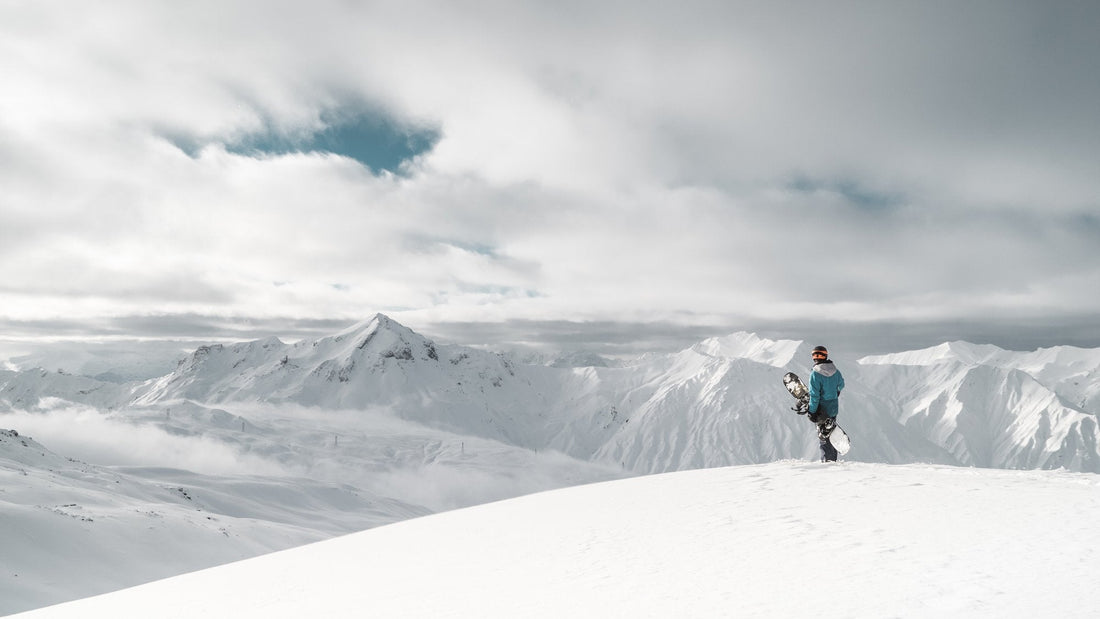
Avoiding Altitude Sickness With Proper Hydration
Share
If your adventures include reaching for the sky on the peaks of Kilimanjaro, K2, or Machu Picchu, you may be familiar with altitude sickness. This common ailment affects many climbers, hikers, and even skiers and snowboarders, sometimes at elevations as low as 8,000 feet. In its mildest form, altitude sickness is an unpleasant experience that resolves quickly, but in severe cases, it can be deadly.
Essential Takeaways:
- For adventurers and travelers seeking higher grounds, avoid the literal headache that comes with the great views by staying hydrated.
- We reveal our secret weapon against altitude sickness.
Before your next adventure in the great outdoors this winter, learn more about how to treat altitude sickness and what you can do to prevent it to enjoy the trip.
- Travel Hazards at High Elevations
- Why Does High Altitude Dehydrate You?
- Types of Altitude Sickness
- General Symptoms of Altitude Sickness
- Diagnosis and Treatment of Altitude Sickness
- How Much Water to Drink to Avoid Altitude Sickness
- Preventing Altitude Sickness
- Hydration at High Altitude: How Water and Electrolytes Help
- Our Secret Weapon Against Altitude Sickness
Travel Hazards at High Elevations
Environments high above sea level carry numerous risks for travelers, including cold temperatures, low humidity, increased ultraviolet radiation, low air pressure, and low oxygen. The level of hypoxic stress depends on many factors, including the rate of ascent, elevation, and duration of exposure, as well as whether you're camping out or sleeping at elevation.
The human body is highly adaptable to different environments, provided it has the time to adjust properly. Acute acclimatization, or the body's adjustment to environmental changes over a short duration, typically takes three to five days. On a climb or hike, this involves stopping for a few days at 8,000 feet before moving on to higher elevations. Taking this time allows proper acclimatization to improve comfort, enhance athletic performance, improve sleep, and prevent altitude sickness.
Inadequate acclimatization can lead to altitude sickness in travelers approaching 8,000 feet or higher. It's even possible to get altitude sickness at lower elevations due to different genetic factors. Assuming an average risk factor, the likelihood of altitude sickness depends on the elevation, rate of ascent, and level of exertion.
Many preexisting medical conditions, such as sickle cell disease, myocardial ischemia, heart failure, obstructive sleep apnea, and any form of hypoxemia or pulmonary insufficiency, can increase the risk of altitude sickness.
Hikers and climbers aren't the only people who experience altitude sickness. Flights that involve rapid climbs to high elevations can bring on altitude sickness in some individuals.
Why Does High Altitude Dehydrate You?
At high altitudes, the air is thinner and contains less oxygen -and it's also much drier. This dry air increases fluid loss through respiration. Every breath you take at altitude causes you to lose more water than you would at sea level, and when combined with exertion, sweat, and more frequent urination, dehydration can become a real risk. Even if you're not sweating excessively, you're still losing water at a higher rate.
Altitude also affects your kidneys. In low-oxygen conditions, the kidneys excrete more bicarbonate to help maintain blood pH, which leads to increased urination. This natural diuretic effect can leave you dehydrated even if you feel like you’ve been drinking regularly. That’s why water alone may not be enough - electrolytes are critical to maintaining hydration efficiency and preventing symptoms like headaches, fatigue, and confusion associated with both dehydration and altitude sickness.
Types of Altitude Sickness
Altitude sickness is divided into three types:
Acute Mountain Sickness (AMS)
AMS is the most common form of altitude sickness. Its symptoms most closely resemble hangovers, including headache, fatigue, nausea, and vomiting. The symptoms typically resolve with 24 to 72 hours of acclimatization.
High-Altitude Cerebral Edema (HACE)
If AMS progresses, it can turn into HACE. During HACE, fluid builds up in the brain, which is a potentially fatal condition. The symptoms of HACE include headache, dizziness, blurred vision, disorientation, and severe nausea or vomiting. In advanced cases, people with HACE can't keep water down or adequately rehydrate. Though rare, HACE can become life-threatening within hours.
High-Altitude Pulmonary Edema (HAPE)
Like HACE, HAPE is a more advanced form of AMS and causes a buildup of fluid in the lungs. It can affect any individual traveling above 8,000 feet, including experienced climbers and athletes. Mild HAPE symptoms include a dry cough and shortness of breath after exertion, but the symptoms may be as severe as shortness of breath at rest, fever, and confusion. HAPE can also be fatal.
General Symptoms of Altitude Sickness

Headache, dizziness, and overwhelming fatigue are hallmark symptoms of altitude sickness and can strike unexpectedly as your body struggles to adjust.
The symptoms of altitude sickness range from mild to severe and typically develop between 6 and 24 hours in a high-altitude environment. Mimicking the symptoms of dehydration or a hangover, the signs may include:
- Headache
- Malaise
- Dizziness
- Fatigue
- Loss of appetite
- Shortness of breath
- Symptoms that worsen at night
Diagnosis and Treatment of Altitude Sickness
Both AMS and HACE produce symptoms that mimic other conditions, making diagnosis more challenging. Symptoms can be the result of altitude sickness, dehydration, fatigue, hypothermia, hypoglycemia, low electrolytes, carbon monoxide poisoning, and more. In many cases, the descent is enough to relieve the symptoms of HACE quickly. Oxygen supplementation is used to relieve the headache of AMS, if available. People affected by mild altitude sickness can also stay at their current elevation and treat with medications as an altitude sickness cure.
In the case of HAPE, the symptoms are clearer but may still indicate other conditions like pulmonary embolism, pneumonia, and myocardial infarction. With HAPE, the descent is urgent and necessary to relieve symptoms. If descent isn't possible, supplemental oxygen or a hyperbaric chamber is vital.
How Much Water to Drink to Avoid Altitude Sickness

At high elevations, aim for about 4–6 liters of fluids daily adjusting for activity level and conditions to help prevent altitude sickness.
The general rule of thumb is to increase your water intake by at least 1 to 1.5 litres per day when at higher elevations. Most experts recommend 4 to 6 litres of fluids daily when hiking or climbing at altitude, depending on your activity level, body size, and weather conditions. But hydration isn't just about water - electrolytes matter too.
Without proper electrolyte intake, excess water can flush out essential minerals like sodium, potassium, and magnesium, leading to imbalances that actually make symptoms worse. A hydration supplement like Buoy’s electrolyte drops ensures your body absorbs and retains water efficiently. So, if your urine is dark or you're feeling dizzy or fatigued, it’s time to boost both your fluids and your electrolytes.
Preventing Altitude Sickness
Acute Acclimatization
As discussed, acute acclimatization is the best way to prevent altitude sickness. Ideally, give your body two or three days of slow descent or rest to adjust before continuing higher. When driving and flying, it's best to rest for 24 hours at lower altitudes. On foot, plan stopping points at lower elevations and travel no more than 1,000 feet each day, including rest days every 3,000 feet.
Climb High, Sleep Low
"Climb high, sleep low" is an old climber's saying with more than a little truth to it. Altitude sickness is more of a concern when sleeping at elevation. It's important to take day trips for acclimatization but sleep at lower elevations to get the necessary oxygen. If you're experiencing any symptoms of altitude sickness, do not sleep at altitude. Descend to sleep at a lower elevation with more substantial air.
Pay Attention to Diet
A high-carbohydrate diet is best for adaptation to elevations and lowering the risk of altitude sickness. Some people experience a drop in appetite that may lead to protein loss over extended periods of time. Iron is also necessary for health and performance at elevation. Iron is a major component of hemoglobin, a type of protein that carries oxygen from the lungs to the cells of the body. Without adequate iron intake, there aren't enough red blood cells to transport oxygen effectively, leading to fatigue. Iron is needed for myoglobin as well, which is a protein that carries and stores oxygen in muscle tissue.
Take Ibuprofen
A study conducted by a physician at the Stanford Hospital & Clinics and a professor at the Stanford University School of Medicine found a positive link between the use of ibuprofen and the prevention of altitude sickness. Ibuprofen, an over-the-counter anti-inflammatory medication that's used to treat headaches and other types of pain, was shown to significantly reduce the incidence of altitude sickness in a trial of 89 men and women. The study also showed less severe symptoms in individuals with altitude sickness.
Take It Easy
Regardless of physical condition prior to altitude trips, it's important to take it slow and avoid overexertion. Trying to push your physical limits too much, especially during acclimatization, can increase the risk of altitude sickness, along with dehydration and edema. While training and fitness are an important part of trip preparation, some athletes don't have the adaptability or erythropoietin (EPO) levels, a type of cytokine that stimulates red cell production, to adjust to elevation quickly.
Hydration at High Altitude: How Water and Electrolytes Help
Hydration and proper electrolyte balance are vital to overall health, especially at high altitudes where dehydration can occur rapidly and affect performance, energy, and mental clarity.
Climbing, hiking, skiing, and snowboarding already take a toll on the body, leading to increased sweat and water loss, which needs to be replenished. In addition, the body's efforts to adjust to low-oxygen environments at altitude can disrupt the balance of electrolytes and water in the body. Studies show that ascent to altitude is associated with changes in fluid and electrolyte composition in test subjects, many of whom later developed altitude sickness. Individuals at high altitudes may experience severe salt and water retention, which contributes to altitude sickness.
Ideally, you should drink between 4 and 6 liters of water per day while climbing, hiking, skiing, or snowboarding at altitude, but this can vary according to water loss, exertion, and other factors. The best way to tell whether you're taking in enough water is by paying attention to your urine. Ideally, your urine should be light yellow and of adequate volume. If urine output decreases or urine is dark and concentrated, it's important to drink more.
Keep in mind that drinking a lot of water means urinating often. Between urination and sweat, your body dumps a lot of electrolytes. To combat electrolyte loss and imbalances that can contribute to illnesses like hyponatremia, or low sodium levels, take an electrolyte supplement during the trip to replenish your electrolytes. Avoid high-sodium foods while taking an electrolyte supplement, however, to ensure that the balance is maintained. You can monitor your electrolyte balance with your urine as well. If your urine is clear and of high volume, it's a sign you may be overhydrated and it's time for more electrolytes to help restore the balance.
Our Secret Weapon Against Altitude Sickness
With so many variables and risk factors, it's difficult to predict the body's response to high altitudes. Preparation is the best defense, giving your body a chance to adjust to the environmental changes. For your next high-altitude adventure, bring some Buoy Drops along. The portable, squeezable bottle is packed with electrolytes and dissolves completely in your favorite drink for on-the-go electrolytes when you need them. Squeeze your Buoy today!
References:
-
High-Altitude Travel & Altitude Illness - Chapter 3 - 2020 Yellow Book. https://wwwnc.cdc.gov/travel/yellowbook/2020/noninfectious-health-risks/high-altitude-travel-and-altitude-illness.
-
Institute of Medicine (US) Committee on Military Nutrition Research. (1996, January 1). Fluid Metabolism at High Altitudes. Nutritional Needs In Cold And In High-Altitude Environments: Applications for Military Personnel in Field Operations. https://www.ncbi.nlm.nih.gov/books/NBK232881/.
- https://www.hammernutrition.com/knowledge/endurance-library/sickness-at-altitude
- https://www.mpma.net/resources/Documents/2017%20Conference/AltitudePreparation2017_2.pdf
- https://www.onemedical.com/blog/live-well/altitude-sickness
- https://acli-mate.com/tips-altitude-sickness-relief/
- https://www.nhs.uk/conditions/altitude-sickness/
- https://www.healthline.com/health/altitude-sickess-prevention#6




